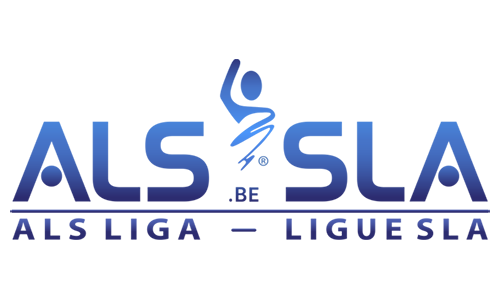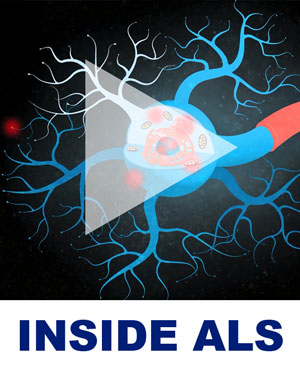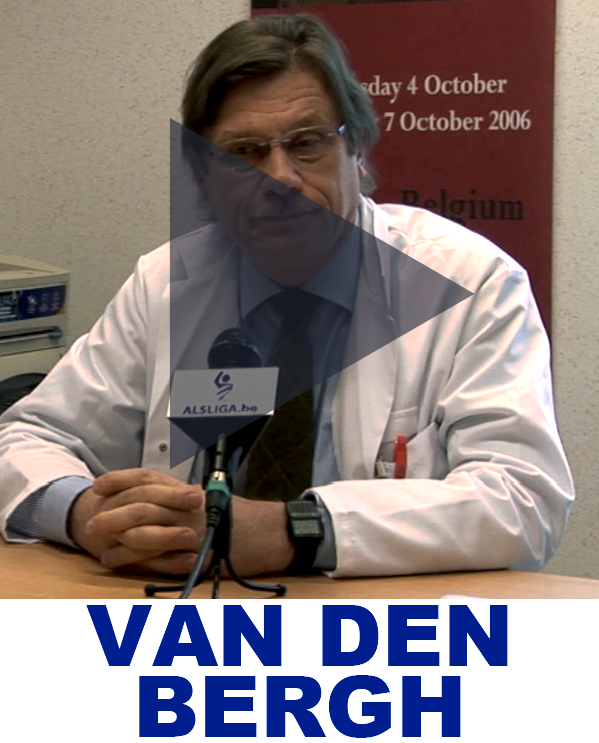What is ALS
Introduction
Amyotrophic Lateral Sclerosis (ALS) is a lethal neuromuscular disease that may affect any muscle group with the exception of the autonomously controlled muscles. An ALS patient dies on average 33 months after diagnosis due to paralysis of respiratory and swallowing muscles. Yet there is a substantial spread regarding the life expectancy of ALS patients.
| ALS | Sclerosis of the outer nerve tract in the spinal cord together with muscle atrophy |
| Atrophy | Disappearance through a lack stimuli |
| Myo- | Muscle |
| Amyotrofic | Diminishing of muscle tissue |
| Lateral | Sidelong |
| Sclerosis | Hardening |
ALS is a non-contagious disorder of unknown cause. Sofar there is no successful treatment or prevention method known. The median survival period after diagnosis and the specific disease progression vary strongly from patient to patient; this variability hampers dependable predictions on an individual basis. Because of this variability, it is also important that patients do not focus blindly on averages. Why should they not be the “lucky exception”? Realistic thinking is, of course, desirable, but there is no need to be over-pessimistic. Stress and fatigue are, sadly enough, factors that have a negative impact on the progression of the disease.
In 1862 Jean-Marie Charcot used the term “Amyotrophic Lateral Sclerosis” for the first time to point out an affection of both the primary as well as the secondary motor neuron. In 1874 it was Charcot who gave the first precise clinical description of ALS. In some countries the disease is also called MND, Motor Neuron Disease.
In the United States of America, the disorder is also known as “Lou Gehrig disease”, after a famous baseball player who died because of the disease in 1941.
ALS, the disease
ALS is a progressive degeneration of the motor neurons in the brainstem and spinal cord. These neurons transfer stimuli from the brain, via the nerves to the muscles. Because these stimuli are not properly transferred any longer, the muscles do not function appropriately.
Of course, this clinical picture should not be viewed in black and white. The heart muscle, for example, is not directly affected by ALS, but stress, fatigue and sadness can adversely affect the functioning of the heart. The intestinal function is also not affected in itself, but when patients absorb less moisture due to swallowing problems, no longer move due to paralysis and their abdominal muscles no longer exert pressure, constipation is a logical indirect consequence of ALS. Sexual functions are also not affected, yet it is not difficult to understand that patients have more urgent concerns as their physical condition deteriorates. It is of course important to know which parts of the body are effectively affected by the disease, but the psychological consequences of this process may not be overlooked (for example loss of appetite, weariness of life, social isolation, depression).
ALS is considered to be painless. This statement should however be interpreted with uttermost caution. The pain induced by ALS is indeed seriously underestimated. Sagging shoulders due to muscle deterioration, joint pains, cramps, effects of sitting motionless over extended periods of time which cause decubitus, bed or pressure sores. Joint pain is mainly due to loss of muscle strength, stiffness to a lack of exercise and freedom of movement. Muscles that are insufficiently activated by nerve stimuli will randomly contract and cause cramps. We have not even mentioned the psychological pains that occur as a matter of course.
Also the mental capabilities may be affected. Approximately 50% of the patients remain cognitively fully capable. About 35% develop mild cognitive or behavioral changes, which are only noticeable after specific testing. About 15% of the patients develop FTD (frontotemporal dementia).
Frontotemporal dementia (FTD) is a drastic change in behavior and language proficiency due to the loss of nerve cells in the frontal and temporal brain areas.
Occurrence of ALS
ALS is not a rare disease as it affects six to seven people out of every one hundred thousand, and occurs all over the world. Most people are affected by ALS around the age of 60. Men are affected slightly more frequently than women. The diagnosis can only be made after exclusion of all other neurologic disorders. Therefore, patients have often already gone through a long-term disease process before they finally get the ALS diagnosis, which in turn may result in an already advanced stage of the disorder at the time of this diagnosis. The course of ALS is explicitly progressive, but its factual evolution varies from person to person. The well-known theoretical physicist Stephen Hawking lived the longest life while suffering from ALS. He actually fought against the disease during over 50 years.
In Belgium thousand people continuously suffer from ALS. On a yearly basis more than two hundred patients pass away and at least as many are diagnosed with ALS. This results in a nationwide constant number of patients. This also means that there is seemingly only a limited number of patients, while it is the precisely the highly degenerative character of the disease that causes a high rate of turnover among patients.
Worldwide approximately 400.000 people suffer from ALS and yearly more than 100.000 of them die. Every year 120.000 people are diagnosed with ALS, which means that every day there are 328 new known cases.
In Europe about 50.000 individuals are affected by ALS, from which about 10.000 people yearly die.
What are the symptoms of ALS?
Weak and thin muscles
The disease starts asymmetrically and distally causing loss in effective muscle power in one hand or one foot as one of the first symptoms. The patient subsequently experiences an increasing number of problems with daily activities (for example tying shoe laces, walking, sports). The disease finally evolves and results in an increasing loss of muscle tissue.
Difficulty to chew, swallow and speak
Eating is a complex process which involves numerous muscles: hand and arm muscles, facial and jaw muscles, the tongue, throat and esophageal muscles. Degradation of these muscles can cause chewing and swallowing problems; in case of a weakening of these muscles, the disease is called “bulbar” ALS. Patients speak indistinctly, their voice gets softer, swallowing and chewing gets more difficult, as do eating and drinking, which can cause drooling in some cases. When the muscles which control swallowing are degrading, saliva and mucus build up in the mouth. Consequently, saliva can run out of the mouth or end up in the respiratory system, which can lead to choking. This can cause the patient and his/her surrounding to panic. However, choking is hardly ever a death cause for ALS patients. The chances of choking increase in case of fatigue, when emotions run high or when a patient talks during eating and drinking.
Practical tips: thicken food, drink hot and cold drinks, concentrate while drinking / eating, keep your head angled slightly downwards and forwards.
Degeneration of the muscle groups used for speaking can also cause communication problems. This phenomenon is called “dysarthria”. Dysarthria goes hand in hand with the aforementioned eating and swallowing problems, as the same muscles are used for chewing, swallowing and speaking. ALS can cause a variety of speech problems, depending on the muscle groups affected. The patient’s voice can become hoarse or nasal, articulating can get more difficult, as can the pronunciation of certain sounds.
Oral hygiene can be affected as well: affected tongue muscles and decreased mobility of the palate can hinder the cleaning of the mouth, which leads to dental caries and infections. Specially adapted nutrition and speech therapy are of utmost importance. Belgians, known as Burgundians for whom the meal is sometimes the ideal time to meet with family members, often have difficulties accepting this.
Weight loss and reduced appetite
Because of the loss of muscle mass, reduced food intake, problems with chewing and swallowing and shame to eat in company, the body weight can quickly drop. Weight is an important parameter to monitor ALS progression. When the body does not receive enough proteins, muscles will start breaking down to compensate for the deficiency. And the muscles are exactly the conductors of stimuli ...
Practical tips: calorie-rich food, full-cream milk instead of skimmed milk, PEG probe
‘I wish I had taken the decision to take a PEG probe 20kg ago’
Trouble breathing
Because of the reduced strength of the respiratory muscles, breathing capacity diminishes and carbon dioxide (CO2) accumulates in the blood, which may result in troubled sleep, nightmares, morning headaches, drowsiness, shortness of breath and even pneumonia. Patients experience a reduced stamina and tire easily.
Acute suffocation rarely happens in ALS, but having difficulties to breathe during an entire illness process, results in severe discomfort. Passing away is usually serene because of a gradual transition into a comatose condition due to an excessive amount of carbon dioxide in the blood.
Fatigue
Fatigue is a common symptom of ALS. Confrontation with the numerous changes in an ALS patients life can result in a general state of stress which can in turn lead to depression and weariness. This last symptom is especially due to a weakening of the diaphragm. Because of the declining lung function, this general weariness increases. All normal activities suddenly require a lot of energy which the body no longer possesses. The psychological acceptance of the diagnosis alone can be challenging and lead to apathy. Patients should learn to listen to their bodies. Washing up quickly, when very tired, is for example totally inappropriate. Recuperation is a term that does not exist in an ALS patient’s vocabulary.
Problems with bowel movement
Constipation can occur because of a lack of moisture absorption, reduced physical exercise and the use of certain medicines. People suffering from ALS will often drink too little out of fear for problems with swallowing and because they are reluctant to ask for help when going to the toilet. Moreover, going to the toilet becomes difficult in itself because of reduced strength in the abdominal muscles. Adapted food and laxatives may help.
Practical tips: provide tools to make drinking as easy as possible; for example straws and straw holders, patient lifting systems, designed to lift patient weight easily - not at the expense of the caregivers back.
Compulsive crying, laughing and yawning
These are disinhibition symptoms of the lower cerebral centers. They often start as a normal reaction to something sad or funny, but become uncontrollable and unstoppable after a certain amount of time. This often leads to a feeling of shame, which can cause social isolation. Medical treatment of this inconvenience is possible.
Types of ALS
1) Leg Type: This type occurs in 30% of the ALS cases and, as its name indicates, starts off in the leg. The patient starts to stumble, sometimes falls, gets a drop foot.
2) Arm Type: This type occurs in 40% of the ALS cases. Patients are struggling with fine motor skills, drop glasses, cannot tie their laces, cannot use the computer any longer.
3) Bulbar type: Bulbar muscles are muscles of the mouth and throat, and are responsible for speech and swallowing. Bulbar ALS occurs in 30% of the cases, and the mucous, speech and respiratory muscles die off first. Often the patients surrounding notes that the patients voice “changes”. The voice becomes unclear and softens, problems with swallowing and chewing occur, food intake and drinking become more difficult, some patients suffer from salivation. The latter does not happen by creating more saliva, but because it can no longer be swallowed. Bulbar ALS is usually known as a somewhat aggressive form, as the respiratory muscles are immediately under pressure.
This classification is based on the location of the body areas in which the disease manifests itself first. In parallel, another classification can be made between the familial and non-familial forms of ALS.
4) Familial or inherited and non-familial or sporadic ALS
Two major forms of ALS are known: familial and sporadic. Familial ALS accounts for about 10% of all ALS cases. As the name suggests, familial ALS (also called fALS) is believed to be caused by the inheritance of one or more faulty genes. About 15% of families with this type of ALS have mutations in the gene for SOD-1. SOD-1 gene defects are dominant, meaning only one gene copy is needed to develop the disease. Each child has a 50% chance to inherit a faulty gene from an affected parent. The symptoms of hereditary ALS are the same as those of non-hereditary form. The only difference is that patients with hereditary ALS are usually younger when the first symptoms occur. Imagine the emotional impact when you are diagnosed with ALS at an age of 70 and you already have children and grand-children !
Most patients - about 90 % - suffer from sporadic ALS (also called sALS). Sporadic ALS has no known cause; the patients family members are not predestined or vulnerable to ALS. Yet, in 8% of the patients with a sporadic ALS form, a gene defect or mutation is still detected.
The symptoms of genetic ALS are identical to those of the non-genetic variant. Both forms may initiate as arm, leg or bulbar variants.
5) In addition, an ALS patient may also develop frontotemporal dementia. Frontotemporal dementia (FTD) is a drastic change in behavior and language proficiency due to the loss of nerve cells in frontal and temporal brain areas. FTD occurs in approximately 15% of ALS patients. FTD jeopardize aspects that characterize the core of human beings: language, personality and the way of dealing with others.
The most common symptoms of FTD are:
- Uncontrolled reactions
- Loss of initiative and interest, indifference
- Socially inappropriate behavior
- Loss of empathy
- Repetitive or perseverative behavior, sometimes with compulsive character
- Changes in eating and taste patterns, sometimes resulting in significant weight gain
- Execution and performance dysfunction, resulting in disorder in planning and organization
It is of course sometimes difficult to determine whether certain symptoms are a result of FTD or of ALS in itself. For example, depression may occur, which may or may not be caused directly by FTD. ALS patients who are struggling to communicate may change their behavior as well: stay inside, avoid contacts with friends and relatives. These are very natural reactions, which may have nothing to do with FTD.








